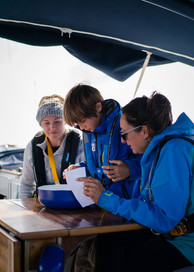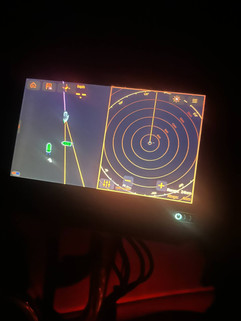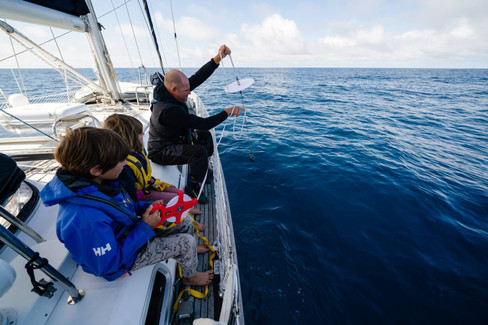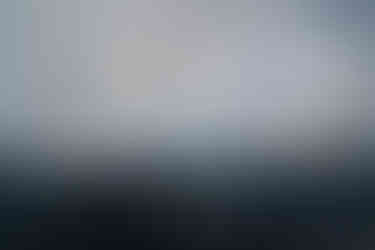Sailing Ucluelet to San Francisco
- Larissa Clark
- Sep 19, 2024
- 4 min read
Updated: Dec 1, 2024
In September 2024 we set sail on a direct voyage of 750nm from Ucluelet, British Columbia to San Francisco, California - it was a big stage for us in our journey so far as it ended the fantastic 18 months we've spent in British Columbia and meant we were finally heading South.

Crew
Name | Role |
Duncan Copeland | Captain |
Larissa Clark | First Mate, First Aid |
Constance Hummel | Crew, Watch Leader, Ass. First Aid |
Nikkey Dawn | Crew, Trip Documentation |
Eden Copeland | Age 7 - wildlife spotter, citizen science helper |
Skye-Elizabeth Copeland | Age 5 - wildlife spotter, citizen science helper |

The voyage took the expected 5 nights 6 days with the typical 'not enough' wind and 'a lot of' wind and 'not always blowing the right way', but primarily they were NW winds with variable 5-30 knots leading to a couple of days and nights in the middle with a sea state at 4-6meters which made for some fun surfing!

We took the ‘offshore’ route, generally 40-50 NM off the coast to avoid inshore fishing activity, with the hope of staying out of larger wave conditions (hmmm) and shipping lanes further offshore.
Once south of Cape Mendocino, we headed closer inshore on a bearing for San Francisco port entrance which we arrived at late in the evening to sail under the twinkling Golden Gate Bridge and into our first USA port where we took anchor at Angel Island.

Highlights from the journey have to be the incredible wildlife we encountered the whole way from sea otters, sea lions, countless humpback whales, three sei whales changing direction and swimming under Freeranger, dolphins at the bow, porpoises, dazzling light shows of bioluminescence, so many birds and seeing pelicans as we entered San Fran, night skies, and for some, big old surfing waves!

Lowlights have to be Larissa's sea sickness and the dreadful thudding coming from the engine room which resulted in 12 days in the yard on arrival to San Fran but let's not dwell on that!
Our voyage plan included participation for half a dozen citizen science projects as below.
Citizen Science Projects
Technology developed in British Columbia helps researchers better understand local whale populations is now being used to protect those same whales. Through Ocean Wise’s Sighting Network we contributed to conservation-based research by submitting sightings of cetaceans (whales, dolphins, and porpoises) when in the waters of British Columbia (B.C.) and northern Washington of which we had many during the passage south. Once we'd left the range of the App we switched to a more local initiative to report our Sei whale encounter!

We've enjoyed helping researchers understand the impact of climate change on phytoplankton by taking regular Secchi depth readings and sharing them on the interactive app which is popular with the kids! This was particularly fun mid-way where we took our deepest reading so far since starting earlier this year. It was amazing for the kids to see the disk going deeper and deeper into clear ocean seas when in BC the waters were so nutrient rich we'd lose it after a few meters.

This is another very interesting project and the one we have the most history with as our crews have contributed over 100 data points to in the study in the past by using a water sample filter and photograph for plankton and microplastics research. This passage was hampered by a failing (lost) O-ring in our GOES filter which meant the samples wouldn't be reliable so it's in for repair and we'll try again next time!

Windrow Observation
With technological advances moving at such pace people sometimes presume everything can be done with 'eyes in the sky' but ground-truthing satellite imagery is still a critical part of technology development for plastic pollution research and beyond. We shared reporting on positions and ground-truthing satellite imagery by observation of "windrows", elongated phenomena on the ocean surface which have little to do with the wind (actually, they form under low winds). They typically have a width of less than 100 meters and their length can exceed 10km. They are seen either as mirror glossy strips of water (due to oily natural or anthropogenic surfactant) or as dense aggregations of floating matter (debris, foam, neuston, etc.). We shared sightings (see one pictured by Nikkey below) of a couple with Nikolai Maximenko at University of Hawaii so he could compare our positions with any slicks in images of ESA's Sentinel-2 (optical) and Sentinel-1 (radar, can see through clouds) satellites.

Velella Observations
Velella, or "by-the-wind sailors," are stunning blue colonial hydrozoans with unique sails that help them drift across oceans. Their angled sails prevent mass strandings, while they play vital ecological roles as plankton predators and prey for specialized species. We kept our eyes peeled to share any sightings of these fascinating creatures at sea with Tom W. Iwanicki, PhD MSc at Georgetown University to help understand the ‘lefty’ v ‘righty’ of this marine species.

We were welcomed into the "Hall of Fame" as a Seakeeper International Discovery Yacht in summer 2024. Before leaving Ucluelet we set up a device they provided to capture passive recording of depth information towards creation of global seabed map by 2023. Privately-owned vessels can participate in increasing our knowledge of the ocean by sharing depth measurements from navigation instruments while out at sea. Yachts explore the world’s oceans, often in areas where data is sparse, non-existent or of poor quality. These are exactly the places where contribution of global seafloor mapping efforts can have the greatest impact.

Ocean Voyages Institute Macro plastic trackers
This was the second Pacific journey our crew has carried trackers aboard for the brilliant Mary Crowley and her team at Ocean Voyages Institute with the hope of deploying them onto large plastic debris in a limited range of the North Pacific Gyre. You need a somewhat perfect set of conditions - calm sea state, mild winds, and macro plastic to show up at the right time. We were in the research area for a day and although we'd had all three during the overall passage they were never timed together - an important reminder of how hard it is to collect data from our ocean offshore!
For more information on any of these projects just get in touch!
Until then, we're off to explore California!
See a gallery of highlights captured by the crew but all the best ones by Nikkey Dawn!





































































































Comments